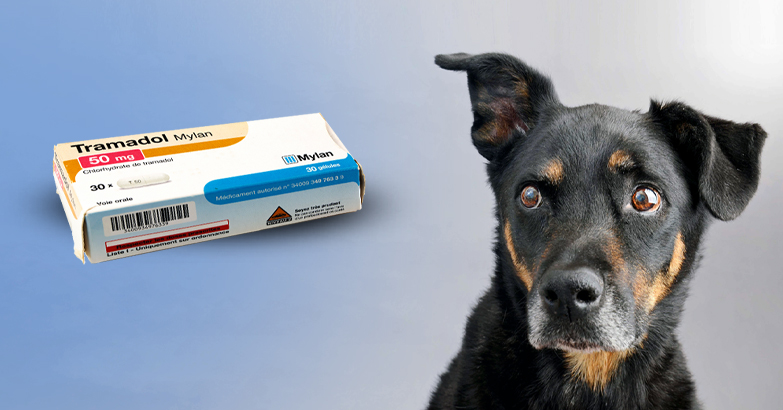Tramadol for dogs is often prescribed for acute or chronic pain. But is it effective and safe for dogs?
Let’s explore the benefits and drawbacks of tramadol for dogs … and look at natural options to manage pain in dogs.
What Is Tramadol For Dogs?
Tramadol belongs to a class of drugs known as opioids, which are said to alleviate moderate to severe pain. Tramadol is an analgesic drug that acts on the central nervous system to relieve pain. It binds to opioid receptors in the brain and spinal cord, to alter the perception of pain and reduce discomfort.
Tramadol’s mechanism of action is to turn off pain pathways in the brain. The cause of the pain may still be there, but the brain doesn’t recognize it as pain. It’s also given as a sedative to help calm anxious or restless dogs. Veterinarians prescribe it for musculoskeletal pain, arthritis and chronic conditions, pain from surgery and pain associated with cancer or degenerative diseases. It may also be used as a cough suppressant or for diarrhea.
RELATED: How vets use pain meds for dogs …
Does Tramadol Relieve Pain In Dogs?
Not always. Research studies indicate that tramadol may not be as effective as people think whether for chronic pain conditions like osteoarthritis, or for acute situations like post-surgical or injury pain relief.
Post-Operative Pain
In fact, a May 2021 study by a team of international veterinary researchers reviewed studies into the efficacy of tramadol in managing postoperative pain for dogs (1). The researchers concluded “the analgesic efficacy of tramadol for postoperative pain management in dogs was low or very low.” They also found that adverse events were inconsistently reported.
In 2013 a group of veterinary researchers at University of Minnesota published a paper in the AVMA Journal (2). They studied 30 dogs receiving tramadol, firocoxib (Previcox) or both, after TPLO surgery, and found that “a significantly greater number of dogs in the tramadol group (8/10 dogs) had a pain score > 6 after surgery, compared with the other groups.” They concluded that “… firocoxib (when used alone) is a more effective analgesic than orally administered tramadol (when used alone).”
Osteoarthritis Pain
In 2019, the American Animal Hospital Association (AAHA) published an article claiming “Prescribing oral opioids for dogs probably doesn’t help them – and could hurt their owners.” The author asserted that, while the use of intravenous tramadol for acute pain during hospitalization is highly effective, dogs don’t absorb oral tramadol well, which lowers its pain-relieving effect.
The article cited a 2018 study of 40 dogs with osteoarthritis by veterinarians at the University of Georgia (3). Researchers concluded … “Data from the present study provided no support for the use of tramadol in dogs with osteoarthritis of the elbow and stifle joint. We believe it highly likely that our findings can be generalized to other joints in dogs with osteoarthritis as well.”
So, the biggest adverse effect may be that tramadol doesn’t work for your dog. if you give your dog tramadol, watch him very closely to make sure it’s helping him.
Is Tramadol Safe For Dogs?
Like all drugs, Tramadol has risks and side effects. Your veterinarian should disclose any likely adverse effects so you can make an informed decision about using tramadol for your dog.
Side Effects Of Tramadol For Dogs
Here are some known side effects of tramadol for dogs. Notify your veterinarian immediately if you notice any of the following:
- Sedation: Tramadol can cause drowsiness, especially when your dog first starts taking the medication or if you increase the dose (only do this with your vet’s advice).
- Gastrointestinal Upset: Some dogs may experience nausea, vomiting, diarrhea or loss of appetite.
- Constipation: Tramadol can cause constipation in dogs and make it difficult for them to poop.
- Slowed Breathing: In high doses or when combined with other medications, tramadol can depress the respiratory system, leading to slowed breathing.
- Coordination Problems: Dogs on tramadol can become unsteady or have difficulty maintaining balance.
- Low Heart Rate: Tramadol can lower your dog’s heart rate, which may be a concern for dogs with pre-existing heart conditions.
- Allergic Reactions: Dogs may develop an allergic reaction to tramadol, which can appear as itching, swelling or difficulty breathing.
- Liver And Kidney Issues: Tramadol may affect liver and kidney function in some dogs, especially those with pre-existing liver or kidney disease.
- Agitation Or Restlessness: Tramadol can be a sedative, but in some dogs, it can cause agitation or restlessness.
- Withdrawal: If a dog stops taking tramadol, it can cause withdrawal symptoms such as tremors, anxiety or even seizures.
Is Tramadol Dangerous For Dogs?
Yes, tramadol can be dangerous for dogs if not used correctly or if given to dogs with certain health conditions.
Dogs Who Should Not Take Tramadol
Some dogs with ongoing health conditions shouldn’t be given tramadol. They include:
- Dogs with a history of seizures or epilepsy. Tramadol can lower the seizure threshold and increase the risk.
- Dogs with liver or kidney disease
- Dogs taking monoamine oxidase inhibitors used for cognitive dysfunction and Cushing’s disease.
- Dogs taking serotonin reuptake inhibitors, which are anti-depressants
- Pregnant or nursing females.
Can Dogs Overdose On Tramadol?
Yes, dogs can overdose on tramadol or any other opioid drug. Always stick to your vet’s dosing instructions and make sure you store tramadol (and other medicines) in a safe and secure place away from pets and children.
Tramadol overdose or other opioid poisoning can cause some of these signs …
- Vomiting
- Slow breathing or heart rate
- Lethargy, weakness or sedation
- Dilated pupils
- Tremors or seizures
- Drooling
- Agitation
- Incoordination, walking as if drunk
- Loss of consciousness or coma
If you see any of these symptoms in a dog on tramadol, get him to your vet or emergency clinic right away. And if you think your dog raided the medicine cabinet and ate opioid drugs, tell the truth about what happened. Veterinarians who see cases of opioid poisoning in pets say the owners “always lie.” Your dog may need a drug like naxolone, an opiate antagonist, to recover from tramadol overdose or opioid poisoning.
Is Tramadol Addictive For Dogs?
Tramadol can cause dependence and therefore withdrawal symptoms in dogs, although the risk of addiction is low. If long-term pain management is necessary, your veterinarian may explore alternative medications or treatment options to reduce the potential for dependence on tramadol.
Do Gabapentin And Tramadol For Dogs Do The Same Thing?
Gabapentin and tramadol are both prescribed to manage pain in dogs, but they work differently. Gabapentin is an anticonvulsant drug that’s also used to alleviate neuropathic pain. It reduces the transmission of pain signals in the nervous system. Tramado acts on opioid receptors in the brain and spinal cord to alleviate pain.
RELATED: Read about the risks of Gabapentin for dogs …
Here are some signs your dog is in pain … and then we’ll suggest some natural options that can help.
Signs Of Pain In Dogs
Dogs can’t communicate their pain or discomfort verbally (although they may whine, whimper or yelp in pain) … so you need to be able to recognize some common signs of pain in dogs:
- Changes In Behavior: Your dog may become unusually withdrawn, restless or lethargic. He might also become irritable, aggressive or not want to be touched or handled.
- Change In Appetite: Your dog might have a reduced interest in food or water, or he might stop eating altogether.
- Vocalization: Dogs in pain may whine, whimper, yelp or even howl. Some dogs are non-vocal or stoic and won’t ever cry out in pain, however, so don’t rely on this as a standalone sign of pain.
- Changes In Activity Level: Dogs in pain may be less active or become reluctant to take part in things they enjoy such as going for walks, or playing fetch. They may have difficulty with stairs, or with getting up or lying down.
- Changes In Posture Or Movement: Your dog might have a hunched or tense posture, be rigid or lean in a certain direction to try to feel better. You may notice limping, favoring a particular leg or joint, or stiffness in movement.
- Excessive Grooming Or Licking: Dogs may excessively groom or lick a specific area of their body that is painful. This is an attempt to provide relief or soothe the affected area.
Some dogs have an instinct to avoid looking vulnerable and may hide their pain altogether. That’s why subtle changes in behavior, appetite and posture might indicate pain in dogs.
10 Natural Alternatives To Tramadol For Dogs
You can explore natural alternatives to tramadol to manage your dog’s pain. Consider these options (and it’s always a good idea to consult a homeopath or herbalist for help choosing the best remedy or herb). If you’re treating post-surgical pain, cancer pain or acute injury pain, the first 3 are your best options.
1. CBD Oil: Cannabidiol (CBD) derived from hemp can provide highly effective pain relief without the psychoactive effects of THC. CBD can work well for acute situations such as post-surgical pain.
2. Herbal Remedies: Herbs such as turmeric, ginger or devil’s claw have analgesic and anti-inflammatory properties that help reduce many types of pain in dogs, whether acute or chronic.
3. Homeopathic Remedies: Well-known remedies like Arnica, especially in high potencies (200C, 1M) can be highly effective in managing post-surgical pain. Start dosing as soon as you can after surgery (but don’t give it before as some say it may interfere with anesthesia.) Homeopathy can also be helpful in managing chronic pain but it’s best to ask a professional homeopath to advise you on the best fitting remedy for your dog’s symptoms.
4. Omega-3 Fatty Acids: Omega-3 fats like green lipped mussel oil have anti-inflammatory properties and can lower pain, especially chronic pain like arthritis.
5. Joint Supplements: Natural joint supplements can support joint health and reduce arthritis pain.
6. Physical Therapy: Rehabilitation exercises, hydrotherapy, chiropractic, acupuncture or massage can relieve pain and improve mobility. Veterinary rehab facilities may use other tools like laser, shockwave or PEMF treatments, which can all be effective in promoting healing.
7. Weight Management: Healthy weight will reduce stress on joints and alleviate pain associated with conditions like arthritis.
8. Cold Or Heat Therapy: Cold packs or warm compresses applied to affected areas can reduce pain and inflammation.
9. Whole Food Diet: Feeding a balanced diet with fresh whole foods can provide proper nutrition and reduce inflammation in the body. Processed foods like kibble can contain pro-inflammatory ingredients that lead to increased pain and stiffness.
10. Adequate Rest: Allow your dog to rest and provide him with a comfortable and supportive bed to help reduce pain and promote healing.
It’s crucial to weigh the pros and cons before using tramadol on your dog … and if you do use it, watch your dog closely to assess whether it’s actually working. It’s often safest to natural options first to avoid potential side effects.
References
- Donati, et al. Efficacy of Tramadol for postoperative pain management in dogs: systematic review and meta-analysis. Veterinary Anaesthesia and Analgesia. May 2021.
- Diana Davila DVM, Thomas P Keeshon et al. Comparison of the analgesic efficacy of perioperative firocoxib and tramadol administration in dogs undergoing tibial plateau leveling osteotomy. JAVMA. Vol 3, Issue 2. 15 July 2013.
- Budsberg SC, Torres BT, et al. Lack of effectiveness of tramadol hydrochloride for the treatment of pain and joint dysfunction in dogs with chronic osteoarthritis. J Am Vet Med Assoc, 2018 Feb 15;252(4):427-432.











